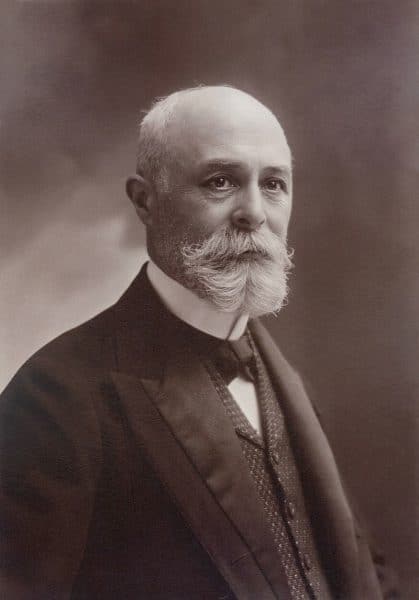
Antoine Henri Becquerel
Antoine Henri Becquerel (December 15, 1852 to August 25, 1908) Henri Becquerel was a French engineer and physicist who discovered radioactivity in 1896, for which he shared the 1903 Nobel Prize in Physics.
Henri Becquerel came from a scientifically talented family. His grandfather (Antoine César Becquerel), his father (Alexandre-Edmond Becquerel), and his son (Jean Becquerel) were all famous scientists in their own right. Henri studied engineering at the École Polytechnique and the École des Ponts et Chaussées (School of Bridges and Highways). In 1892, he was appointed Professor of Applied Physics in the Department of Natural History of the Paris Museum and not long afterwards was appointed chief engineer at the Department of Bridges and Highways. Around that time he became interested in the phenomenon of phosphorescence, which his father had also studied. Phosphorescent materials glow after being exposed to light of shorter wavelengths. (Many glow-in-the-dark toys, stickers, and so on, use such materials.) In 1895, Wilhelm Röntgen created quite a sensation both in the scientific world and in the general public by his discovery of X-rays, and this gave Becquerel the idea that phosphorescent materials might emit X-rays if exposed to bright light. He therefore subjected phosphorescent Uranium salts (a supply of which he had inherited from his father) to bright sunlight and looked for evidence of X-rays using photographic plates. At first, he thought he had found such evidence and thereby confirmed his hypothesis of a connection between phosphorescence and X-rays. But then, because of a happy accident, he realized that he had discovered something much more dramatic. Storing some of the Uranium salts that had not been exposed to bright sunlight in a dark compartment with some photographic plates, he found that images were nevertheless produced on the photographic images. The Uranium was spontaneously emitting some kind of rays. What Becquerel had discovered was a new phenomenon: radioactivity. Very soon after that, Marie Skłodowska Curie and her husband Pierre Curie found radioactivity the in element Thorium and also discovered two new elements, Polonium and Radium, which also exhibited radioactivity. For these discoveries, the 1903 Nobel Prize in Physics was shared between Becquerel (who received half) and the Curies. Becquerel made other discoveries about radioactivity, including that magnetic fields bend the trajectories of particles emitted by radioactive materials in different ways, showing that some of those particles are electrically positive, some negative, and some neutral. In particular, he showed that the particles emitted by Uranium are charged, whereas X-rays are neutral.
Henri Becquerel received numerous honors besides the Nobel Prize in his lifetime, including the Rumford Medal, the Helmholtz Medal, the Barnard Medal of the U.S. National Academy of Sciences, and membership in the Académie des Sciences, the Accademia dei Lincei, the Royal Academy of Berlin, and foreign membership in the British Royal Society. A commonly used unit of radioactivity is named after him.
Although from a Catholic family, Henri Becquerel left the faith as an adult, but returned to it later in life. The priest who presided at his funeral recounted in his homily that Becquerel had said to him two years earlier, “For me, it was my very works [i.e. scientific works] that brought me back to God and to faith.” The priest went on to say,
“To this God, rediscovered on the paths of science, he paid homage not only by a cold conviction of the mind, but indeed by his will and his life, submitting to all the requirements of Christian discipleship, coming every Sunday to this church to repeat the prayers, relearned without difficulty from his childhood, and associating in his daily prayers in the family sanctuary all those who lived under his roof, thus giving both in the privacy of the home and in public the testimony and example of his faith.”
Explore Other Scientists
It is our hope that this curated set of biographies will be useful to teachers, students, and the general public.